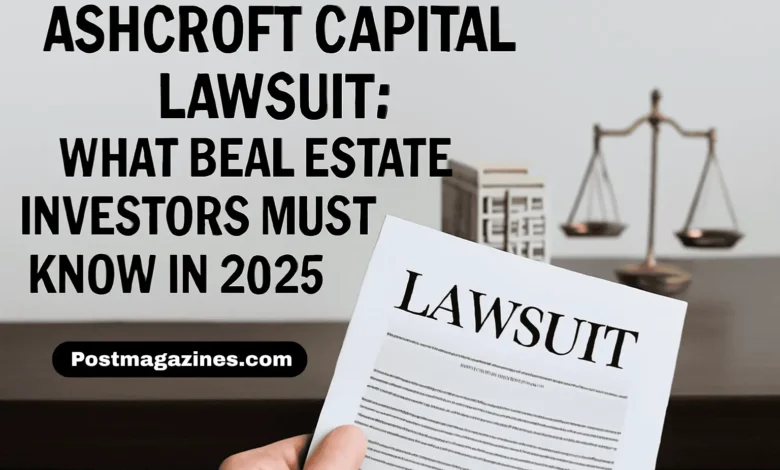Ashcroft Capital Lawsuit: What Real Estate Investors Must Know in 2025

The real estate investment world has recently been rocked by the news of the Ashcroft Capital lawsuit, which involves serious allegations against one of the industry’s leading syndication firms. As the case gains traction, investors, legal analysts, and financial professionals closely monitor the situation. In this comprehensive article, we’ll delve into the origins of the lawsuit, the nature of the allegations, Ashcroft Capital’s response, legal implications, and what this could mean for future real estate syndications.
What Is Ashcroft Capital?
Ashcroft Capital is a private real estate investment firm co-founded by Frank Roessler and Joe Fairless, two well-known figures in the multifamily syndication space. Based in New York, the company specializes in value-add multifamily properties. It often acquires underperforming apartment complexes and enhances them to increase value and generate attractive returns for investors.
With a strong reputation for transparency, professionalism, and investor communication, Ashcroft Capital has managed over $2 billion in real estate assets and boasts an extensive network of accredited investors and partners. Their popular podcast, “Best Ever Real Estate Investing Advice Ever,” has further bolstered their visibility in the investment community.
However, this reputation is now under scrutiny due to a recent lawsuit questioning their business practices.
Overview of the Ashcroft Capital Lawsuit
Key Allegations
Filed by a group of disgruntled investors, the lawsuit accuses Ashcroft Capital of:
- Misrepresentation of Investment Returns
- Investors allege the company made overly optimistic financial projections, creating unrealistic return expectations. These projections were used to attract investments, but the actual performance of several deals has reportedly fallen far below what was promised.
- Breach of Fiduciary Duty
- The core of the lawsuit claims that Ashcroft Capital failed to act in the best interest of its investors. Plaintiffs argue that the company prioritized its fees and profitability over investor returns.
- Lack of Transparency and Communication
- Several investors assert that when projects began underperforming, Ashcroft Capital stopped providing timely updates, leaving them in the dark about the proper financial health of their investments.
- Improper Use of Funds
- It is also alleged that Ashcroft Capital used investor funds in ways not previously disclosed, possibly to cover unrelated business expenses or underperforming projects, which may violate their contractual agreements.
- Regulatory Violations
- The lawsuit hints that some of Ashcroft’s deals may have been offered to non-accredited investors, or that sufficient due diligence wasn’t performed to ensure compliance with SEC regulations.
Ashcroft Capital’s Response
In response to the allegations, Ashcroft Capital has firmly denied any wrongdoing. They have released statements suggesting:
- All investors were vetted and met the accreditation standards required by the SEC.
- Financial projections provided during fundraising were based on market data and conservative underwriting assumptions.
- Any underperformance is attributed to macroeconomic conditions, including interest rate hikes, inflation, and changes in the housing market.
- They remain committed to investor transparency and compliance, asserting they will vigorously defend themselves in court.
Ashcroft Capital has also taken legal action to dismiss certain portions of the case, citing a lack of factual basis and breach of arbitration clauses in investor agreements.
Legal Analysis: A Deeper Look
Fiduciary Duty and Investor Protections
At the heart of the lawsuit lies the concept of fiduciary duty—a legal obligation that requires investment firms to act in the best interests of their clients. If Ashcroft Capital diverted funds, concealed poor performance, or prioritized internal fees, this could lead to severe civil penalties and potential regulatory sanctions.
Private Placement & SEC Compliance
Private real estate syndications are typically offered under Regulation D exemptions, which require offerings only to accredited investors. If Ashcroft Capital failed to confirm investors’ eligibility or misrepresented investment risks, it could attract attention from the Securities and Exchange Commission (SEC).
Discovery Phase
As of mid-2025, the case is in the discovery phase, where both parties must produce documents, communications, and financial records. The outcome of this phase could heavily influence whether the case moves to trial or is settled out of court.
Investor Reactions and Industry Impact
Loss of Confidence
Many investors are concerned not just about Ashcroft Capital but also about multifamily syndications in general. Real estate investing often involves long hold periods and illiquid assets. Investors could lose confidence in similar passive investment models if transparency is compromised.
Calls for Reform
Industry insiders suggest this lawsuit could lead to new regulations requiring syndicators to provide more comprehensive disclosures, conduct third-party audits, and enforce stricter reporting timelines. The case might even set a legal precedent that reshapes how private placements are marketed and managed.
Influence on Passive Investing
Ashcroft Capital was considered a role model in the syndication world. The lawsuit has prompted passive investors to take a more complex look at their investment sponsors, emphasizing the importance of:
- Performing independent due diligence
- Reviewing Private Placement Memorandums (PPMs) thoroughly
- Verifying sponsor track records
- Requesting ongoing financial statements and project updates
Ashcroft Capital’s Future: What Lies Ahead?
While the conclusion of the lawsuit remains uncertain, several potential scenarios are possible:
- Settlement Agreement
- Ashcroft Capital may settle the case privately to avoid further reputational damage, refunding a portion of investor funds or offering equity adjustments.
- Court Ruling in Favor of Investors
- If found liable, the firm could face financial penalties, be forced to restructure its business, and even return investor capital in specific deals.
- Dismissal of the Lawsuit
- The lawsuit may be dismissed if Ashcroft Capital proves that all projections were fair, disclosures were clear, and investor standards were met.
- Regulatory Scrutiny
- Even if civil claims are resolved, the SEC or state securities regulators may initiate their investigations, especially if regulatory violations are substantiated during discovery.
Lessons for Investors
This lawsuit serves as a cautionary tale. Here are some key takeaways:
- Don’t rely solely on reputation or marketing: Even the most popular firms can encounter legal trouble.
- Understand the deal structure: Read all documents carefully—PPMs, subscription, and operating agreements.
- Ask tough questions: Before investing, ask about the worst-case scenario, debt structure, exit strategy, and economic stress testing.
- Demand accountability: Sponsors should provide quarterly reports, audited statements, and consistent updates.
- Diversify: Avoid putting too much capital in one sponsor, market, or asset class.
Conclusion
The Ashcroft Capital lawsuit has become a flashpoint in the real estate investment. As this legal battle unfolds, it’s reshaping how investors think about trust, due diligence, and sponsor accountability. Whether Ashcroft Capital is vindicated or found liable, the impact of this lawsuit will reverberate through the syndication industry for years to come.




